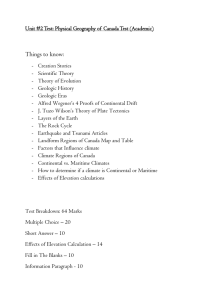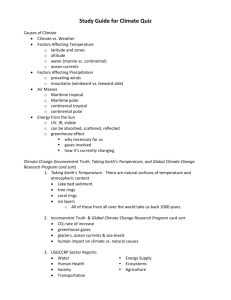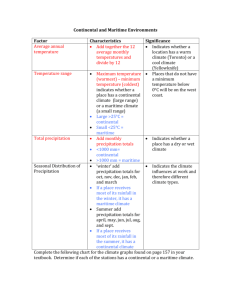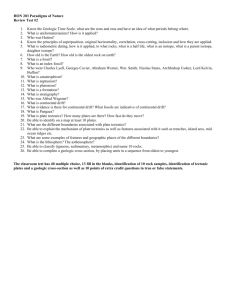Earth Science - pams
advertisement
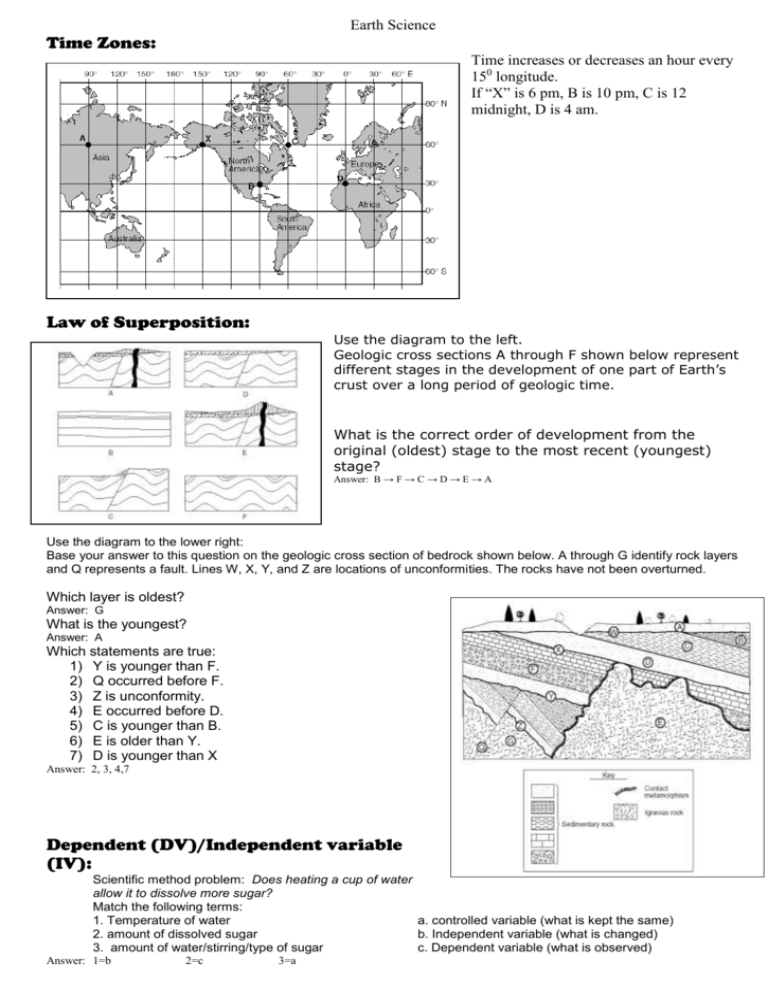
Earth Science Time Zones: Time increases or decreases an hour every 150 longitude. If “X” is 6 pm, B is 10 pm, C is 12 midnight, D is 4 am. Law of Superposition: Use the diagram to the left. Geologic cross sections A through F shown below represent different stages in the development of one part of Earth’s crust over a long period of geologic time. What is the correct order of development from the original (oldest) stage to the most recent (youngest) stage? Answer: B → F → C → D → E → A Use the diagram to the lower right: Base your answer to this question on the geologic cross section of bedrock shown below. A through G identify rock layers and Q represents a fault. Lines W, X, Y, and Z are locations of unconformities. The rocks have not been overturned. Which layer is oldest? Answer: G What is the youngest? Answer: A Which statements are true: 1) Y is younger than F. 2) Q occurred before F. 3) Z is unconformity. 4) E occurred before D. 5) C is younger than B. 6) E is older than Y. 7) D is younger than X Answer: 2, 3, 4,7 Dependent (DV)/Independent variable (IV): Scientific method problem: Does heating a cup of water allow it to dissolve more sugar? Match the following terms: 1. Temperature of water a. controlled variable (what is kept the same) 2. amount of dissolved sugar b. Independent variable (what is changed) 3. amount of water/stirring/type of sugar c. Dependent variable (what is observed) Answer: 1=b 2=c 3=a Which variable is measured rather than manipulated? IV or DV Answer: DV First born children will learn to speak at a younger age than second born children? Which is true based on the statement above? 1) The dependent variable is order of child 2) The dependent variable is age the child learns to speak. Answer: 2 (You will change order of child but measure the ability to learn to speak younger) Positive people have more friends than negative people Which is true based on the statement above? 1) The dependent variable is the positivity of the participant 2) The dependent variable is the number of friends Answer: 2 Participants will react quicker to a light than a buzzer. Which is true based on the statement above? 1) The dependent variable is the stimulus - light or buzzer. 2) The dependent variable is reaction speed. Answer: 2 Participants who exercise regularly are happier than those that don't. Which statement is true based on the statement above? 1) The independent variable is frequency of exercise. 2) The independent variable is happiness. Answer: 1 Which variable is manipulated 1) Independent variable 2) Dependent variable Answer: 1 Horses can swim faster than dogs Which statement is true based on the statement above? 1) The dependent variable is type of animal 2) The dependent variable is speed of swimming Answer: 2 High / Low pressure systems Low= counterclockwise, inward, rising air L’s= light, lousy High= clockwise, outward, sinking air H’s= Heavy, happy Fronts Steep frontal boundary Stormy Decreasing temps Short rain Sometimes violent weather Gradual frontal boundary Rain may last for hours or days (due to the distance the front covers) Sometimes rain (sometimes steady rain) Increasing temps Generally less violent than cold fronts Air masses air masses are classified according to the characteristics of their source region or area of formation Air masses are also classified as being either continental or maritime in terms of moisture characteristics mP= maritime polar (wet and cold) cP=continental polar (dry and cold) mT=maritime tropical (wet and warm) cT=continental tropical (dry and warm) A=continental arctic (cold) Meteor/Meteoroid/Meteorite Meteoroid= object in space Meteor= space object that enters Earth’s Atmosphere, shooting star Meteorite= space object that strikes a planets surface Clouds Rocks Sedimentary Igneous Metamorphic Compaction and Cementation Clastic/chemical/organic May contain fossils Sandstone Limestone Shale conglomerate Cooling magma Intrusive/extrusive Classified by texture and composition Porphyritic, glassy, coarse-grained, finegrained Granite, obsidian, pumice, rhyolite scoria Crystal size depends on cooling rate Heat and pressure Foliated/nonfoliated Schist gneiss marble (derived from limestone) quartzite (sandstone) slate (shale)
